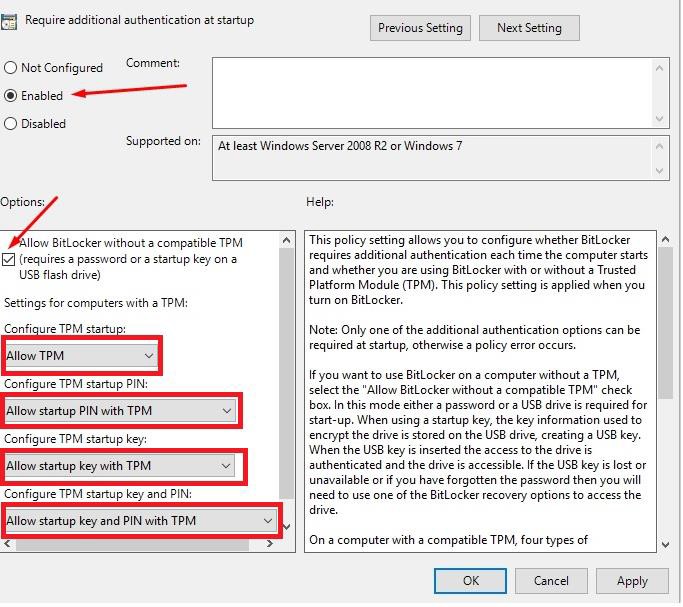
In our previous article we wrote on how Bitlocker can possibly be used as a full disk encryption solution for PCI-DSS.
One of the key things is for the following statement to be complied to:
If disk encryption is used (rather than file- or column-level database encryption), logical access must be managed separately and independently of native operating system authentication and access control mechanisms (for example, by not using local user account databases or general network login credentials). Decryption keys must not be associated with user accounts.
By enabling TPM itself doesn’t guarantee that the native authentication is separated from the logical access to the encrypted file system.
The below basically enables TPM with PIN to ensure that there is an additional logical access that is required to comply to PCI-DSS.



So overall, this means that Bitlocker needs an extra authentication when the server restarts. As the policy states, either a passphrase or USB will be required for the startup, and from PCI perspective, this addresses the separate authentication requirement.
Of course the major discussion here is what is compliance and what is practical security?
Because when was the last time you actually restarted your server? The fact is that full disk encryption is only as useful as it is to protect data on the disk when the system is not running. When the server is running, access to the disk remains open and therefore, we see unprotected PANs with their pants dropped (so to speak).
We are not saying that bitlocker cannot comply to 3.4.1 of PCI. We are saying probably PCI might be better off relooking at this 3.4.1 and clarify the ‘spirit’ of this requirement. At the end, we are concerned with loss of PAN. We are concerned with the fact that files may be taken away, siphoned away through a variety of means – either through the network, or USB, or photos on your phone etc.
The problem with Full Disk Encryption is that even if we do have separate authentication to boot up into the server, once it’s booted and once authenticated separately, the full disk encryption no longer does the job of ‘rendering PANs unreadable where they are stored’. The argument thus comes about that once that occurs, then whoever is reading those PANs are authorised users already with business requirements to view those PANs.
In our opinion, there needs to be much more security surrounding these servers with PANs that use full disk encryption. Access must be limited again to only those with business justification, and not be used for multiple purposes and especially not for non-PCI usage. Logical access, hardening, logging and monitoring obviously needs to be in place. Protection of the PIN must be in place, and changes of PINs based on PCI-DSS expiry policies.
The comfort level of FDE vs say, file encryption or even folder encryption is much less. Whether it meets 3.4.1, if done properly, it clearly does. But is it truly secure? Therein lies that discrepancy between compliance and security. It ticks the checkbox (for now, unless PCI alters it in 4.0), but from a security standpoint, there is a lot of risk surrounding it.
If you use FDE, don’t expect your QSA to just take it lying down. Most likely further queries will be made and some may deem it even insufficient in itself to address the risks of PAN being compromised and may request additional controls on top of it.
If you have further queries on FDE or any compliance programs like PCI, ISO etc, drop us an email at avantedge@pkfmalaysia.com and we will attend to it immediately!